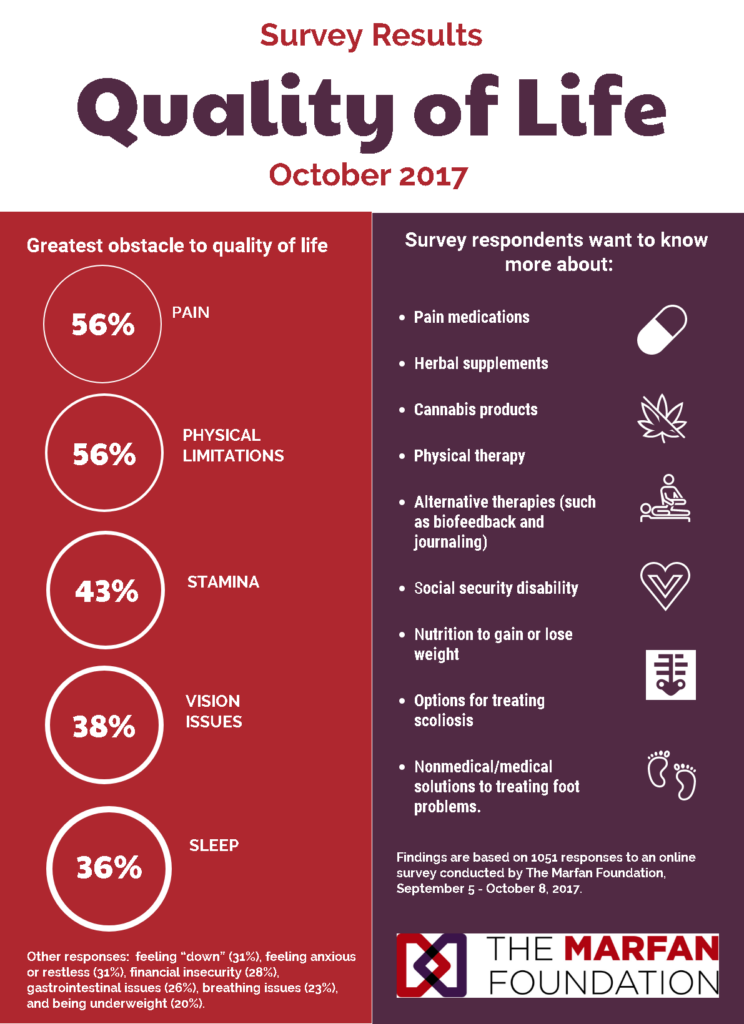
In a survey conducted by The Marfan Foundation to identify the quality of life issues in the Marfan and related disorders community, more than half of the 1,051 respondents reported that pain (56%) and physical limitations (56%) are the greatest obstacles. The other most common challenges were lack of stamina (43%), vision issues (38%), sleep (36%), feeling “down” (31%), feeling anxious or restless (31%), financial insecurity (28%), gastrointestinal issues (26%), breathing issues (23%), and being underweight (20%).
This survey was conducted to not only identify the challenges, but also to determine the greatest needs in the community so that the Foundation can create new resources that can directly impact the most people.
The online survey of people with Marfan or a related disorder (or a parent of an affected child) was conducted from September 5- October 8, 2017. Nearly 65% of respondents were between the ages of 20 and 59, with the highest percentage (18%) between the ages of 30-39. Nearly 85% have Marfan syndrome, while other related disorders were also represented — Loeys Dietz syndrome (29 people) and Ehlers Danlos syndrome (24 people) were the other diagnoses most often cited.
Quality of life is a serious concern among people in the Marfan and related disorders. One survey participant was worried about “what my future might be” while another simply said that life “can be stressful.” Sadly, one noted that, “I have no life outside my own home and doctor visits. Every morning I awake and wonder why I’m still here.”
The Marfan Foundation’s Quality of Life initiative seeks to develop programs and services so that people with Marfan and related disorders who are living longer because of medical advances can also live a better life that is enjoyable, productive, and satisfying.
According to the survey, the most common ways people currently address obstacles to quality of life are listening to music (45%), pain medications (40%), mindfulness (29%), physical therapy (23%), and herbal supplements (16%). One person said they “suck it up” while another noted that they “listen to or watch comedy because it lifts my spirits.”

Topics that respondents want to know more about are pain medications, herbal supplements, cannabis products, physical therapy, alternative therapies (such as biofeedback and journaling), social security disability, nutrition to gain or lose weight, options for treating scoliosis, and nonmedical/medical solutions to treating foot problems.
“The survey findings confirm that our patient population has significant medical issues that impact their day-to-day functioning. When traditional medicine does not solve their issues, they look to alternative treatments to manage the pain that comes from joint and muscle issues, frequent surgeries, and bone problems,” said Maya Brown Zimmerman, a member of the Foundation’s Board of Directors and co-chair of its Quality of Life Task Force. “The Foundation is now focused on educating the community on alternative treatment options, as well as funding and supporting research to address the various medical issues that patients with Marfan and related disorders face. I look forward to a time where we can claim victory over chronic pain related to Marfan syndrome and related disorders.”
In response to the needs of the community, the Foundation will work with its Quality of Life Expert Panel to develop new fact sheets and informational articles for the website and Connective Issues, our regular magazine. In addition, these topics will be considered for annual conference presentations and workshops, as well as for presentations at regional symposiums throughout the year.

The Marfan Foundation is a nonprofit organization that saves lives and improves the quality of life of individuals with genetic aortic and vascular conditions including Marfan, Loeys-Dietz, and Vascular Ehlers-Danlos syndromes. Our vision is a world in which everyone with genetic aortic and vascular conditions can live their best life.
